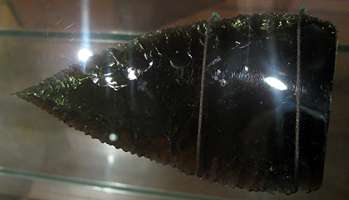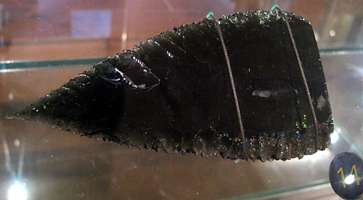Back to Don's Maps
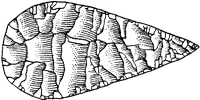 Tools and Decorative Objects of the Stone Age
Tools and Decorative Objects of the Stone Age Kimberley Points - superbly made tools from the north of Australia
Kimberley Points are a particular type of stone (or after white contact, glass) tools, superbly made, demonstrating mastery of the knapping technique, from the north of Australia.
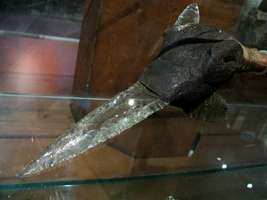
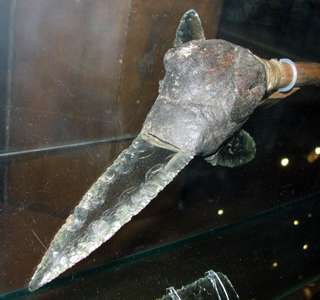
A dangerous looking club, with three points set into the head.
The caption reads:
Club made from wood, European bottle glass, sinew and resin.
Acquired 1917
Artist unknown
Kimberley region, Western Australia
This club has a bulbous resin head into which several glass spear points have been fixed. At the other end of the club's wooden shaft is another knob of resin with a single glass flake in it. The club was probably used in warfare.
Photo: Don Hitchcock April 2010
Source: Australian Museum Display, Sydney

Kimberley blade set in resin and mounted on a wooden handle. This looks to me like a surgical blade, used for cutting cicatrices into the chests of young men going through initiation rites. The fact that it was from the Kimberleys, but was found in Central Australia, lends credence to its being a very important artefact, used for ceremonies, not prosaic uses such as food preparation or butchering of carcasses.
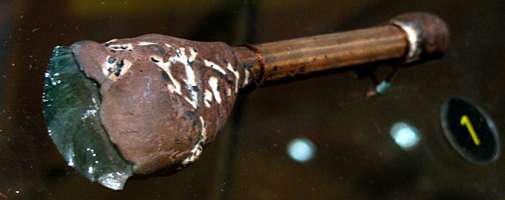
The caption reads:
Knife with European bottle glass set into resin and painted wooden handle
Acquired 1951
Artist unknown
Central Australia
This knife, although found in Central Australia, was made using a precision blade from the Kimberley region.
Photo: Don Hitchcock April 2010
Source: Australian Museum Display, Sydney
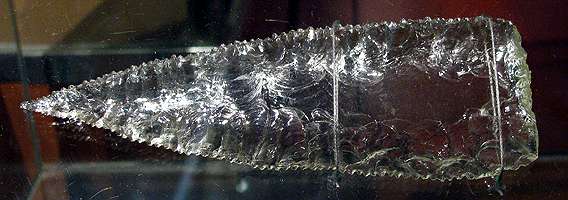
Kimberley point, with a finely worked denticulate margin, made like a jewel from clear bottle glass.
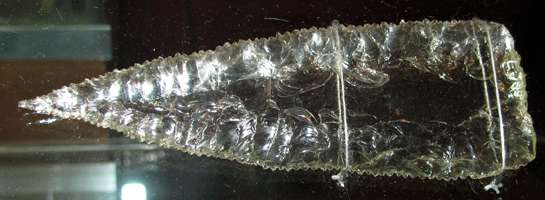
The caption reads:
Spear point made from European bottle glass
Acquired 1924
Artist unknown
Kimberley region, Western Australia
People from the Kimberley region are renowned for producing finely worked precision tools which were traded across Australia. Spear points, such as this, were manufactured [originally] from stone. The fine edges were produced by pressure flaking.
Photo: Don Hitchcock April 2010
Source: Australian Museum Display, Sydney

Awl made of pearlshell.
The caption reads:
Pearlshell pricker attached with resin to ochred wooden handle.
Acquired 1895
Artist unknown
The Vernon, Northern Territory
This shell pricker was used for a variety of tasks including piercing animal skins for sewing cloaks, making holes in bark for constructing canoes and manufacturing fishing nets.
Photo: Don Hitchcock April 2010
Source: Australian Museum Display, Sydney
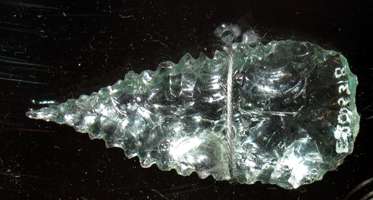
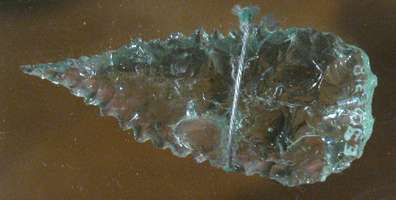
Small point, using glass with a blue tinge.
The caption reads:
Spear point made from European bottle glass
Acquired 1912
Artist unknown
Kimberley region, Western Australia
Photo: Don Hitchcock April 2010
Source: Australian Museum Display, Sydney
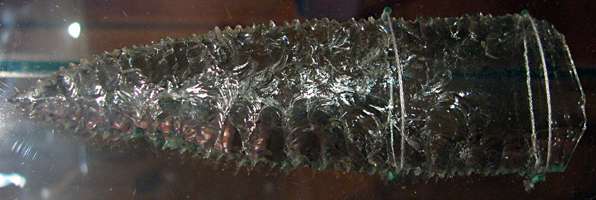

Superbly made point by a master craftsman using pressure flaking with total control of the technique, with tiny and regular teeth on the margin. This one took my breath away.

The caption reads:
Spear point made from European bottle glass
Acquired 1916
Artist unknown
Forrest River, Exmouth Gulf
Northern Western Australia
Photo: Don Hitchcock April 2010
Source: Australian Museum Display, Sydney
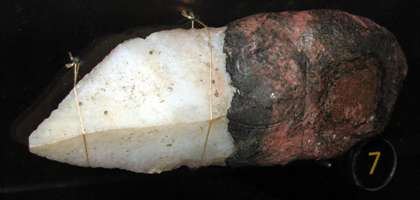
This stone knife appears to have been made from a fine grained white quartzite blank. The sharp point appears to have been broken off with use, and the working edges appear to have been retouched over time to maintain sharpness of the tool, with most apparent wear being close to the resin "handle".
The caption reads:
Stone knife with resin
Acquired 1943
Artist unknown
Coopers Creek
north-west New South Wales
This knife was used for food preparation. Half of the elongated stone blade has been covered with a resin grip.
Photo: Don Hitchcock April 2010
Source: Australian Museum Display, Sydney
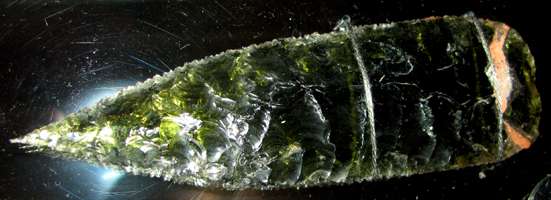
This point was done using green glass, creating a glowing, emerald like object with a staggeringly sharp and elongated point. This tool could never have been actually used, it was obviously made as a trade and status object.
The entire surface is covered with pressure flaking scars.
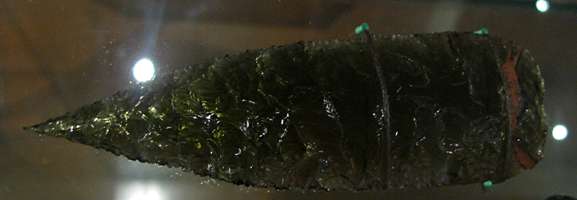
The caption reads:
Spear head made from European bottle glass
Acquired 1902
Artist unknown
Kimberley region, Western Australia
Photo: Don Hitchcock April 2010
Source: Australian Museum Display, Sydney
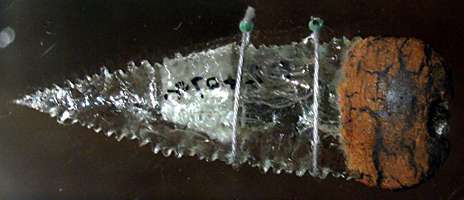

This appears to be one of the very few Kimberley points actually made up ready to be attached to a spear, rather than being simply a trade object.
At the same time, it shows no sign of actual use.
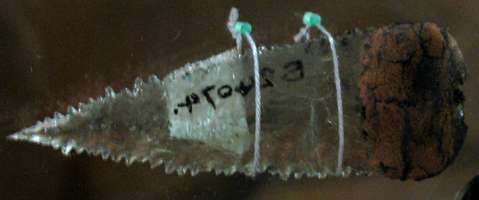
The caption reads:
Spear point made from European bottle glass with resin
Acquired 1916
Artist unknown
Belmaningarra, northern Western Australia
Photo: Don Hitchcock April 2010
Source: Australian Museum Display, Sydney
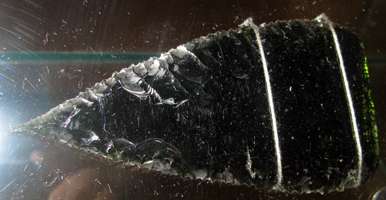
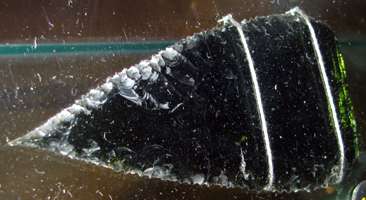
By far the most difficult of the points to get a good image of. The dark glass used makes getting an acceptable image very hard indeed. Yet the point itself is a masterwork.
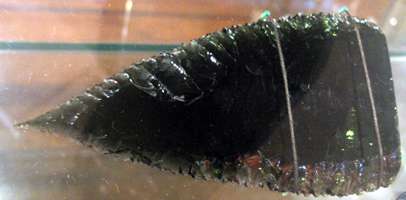

Although very fragile, the point is totally unmarked, as though it had come a few seconds earlier from the hands of the master craftsman who created it. Although it has obviously been made in the Kimberleys, and is part of that tradition, it was traded across several tribal boundaries, and was collected at Powell's Creek in Central Australia.
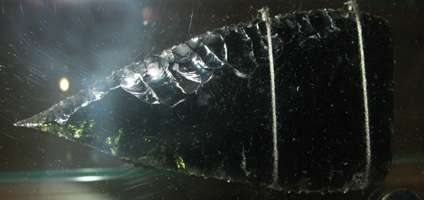 The caption reads:
The caption reads:
Spear head, known as a 'Kimberley point' made from European bottle glass
Acquired 1895
Artist unknown
Powell's Creek, Central Australia
Photo: Don Hitchcock April 2010
Source: Australian Museum Display, Sydney
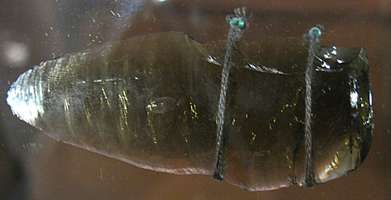

From a totally different tradition, and with a different purpose entirely, this knife was used for surgery.
This blade was struck from glass and not retouched at all, because its intended purpose was to make clean and sharp cuts in human flesh when it was necessary to remove objects such as spear points from the body after battle, or to cut cicatrices in the chest and back which were then packed with ash for male initiations.
It appears to have a positive bulb facing the viewer, with a negative bulb on the other side of the knife, judging by the striations visible through the blade.
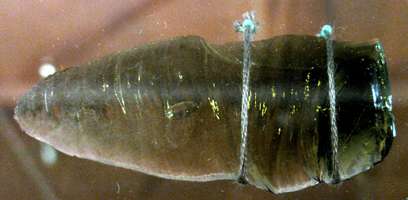
The caption reads:
Glass surgical knife without handle
Acquired 1895
Artist unknown
Sturts Creek, head of Victoria River
Northern Territory
Photo: Don Hitchcock April 2010
Source: Australian Museum Display, Sydney
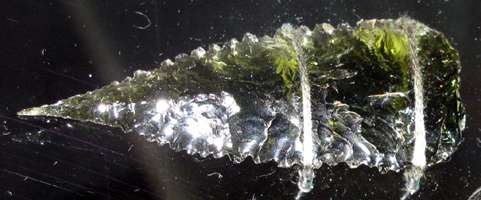
The caption reads:
Spear point made from European bottle glass
Acquired 1912
Artist unknown
Kimberley region, Western Australia
Photo: Don Hitchcock April 2010
Source: Australian Museum Display, Sydney

This surgical knife has an odd dark striation in the glass, as though the glass was first melted before being fashioned into a knife.
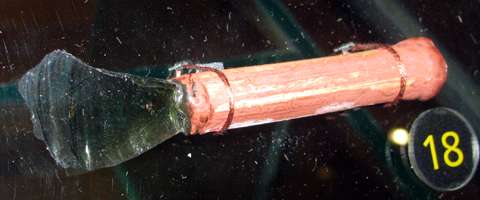
The caption reads:
Glass surgical knife with ochred wooden handle and plant resin
Acquired 1895
Artist unknown
Sturts Creek, head of Victoria River Northern Territory
Photo: Don Hitchcock April 2010
Source: Australian Museum Display, Sydney
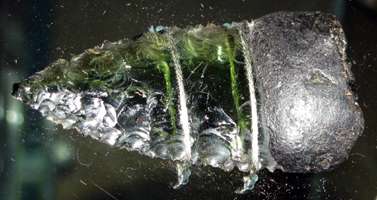
This thin point of green glass has been used, and the fragile sharp point has been broken off. The point was attached to a shaft with resin, which still adheres to the base of the tool.
The caption reads:
Spear point made from European bottle glass
Acquired 1912
Artist unknown
Kimberley region, Western Australia
Photo: Don Hitchcock April 2010
Source: Australian Museum Display, Sydney
Back to Don's Maps
 Back to Archaeological Sites
Back to Archaeological Sites
